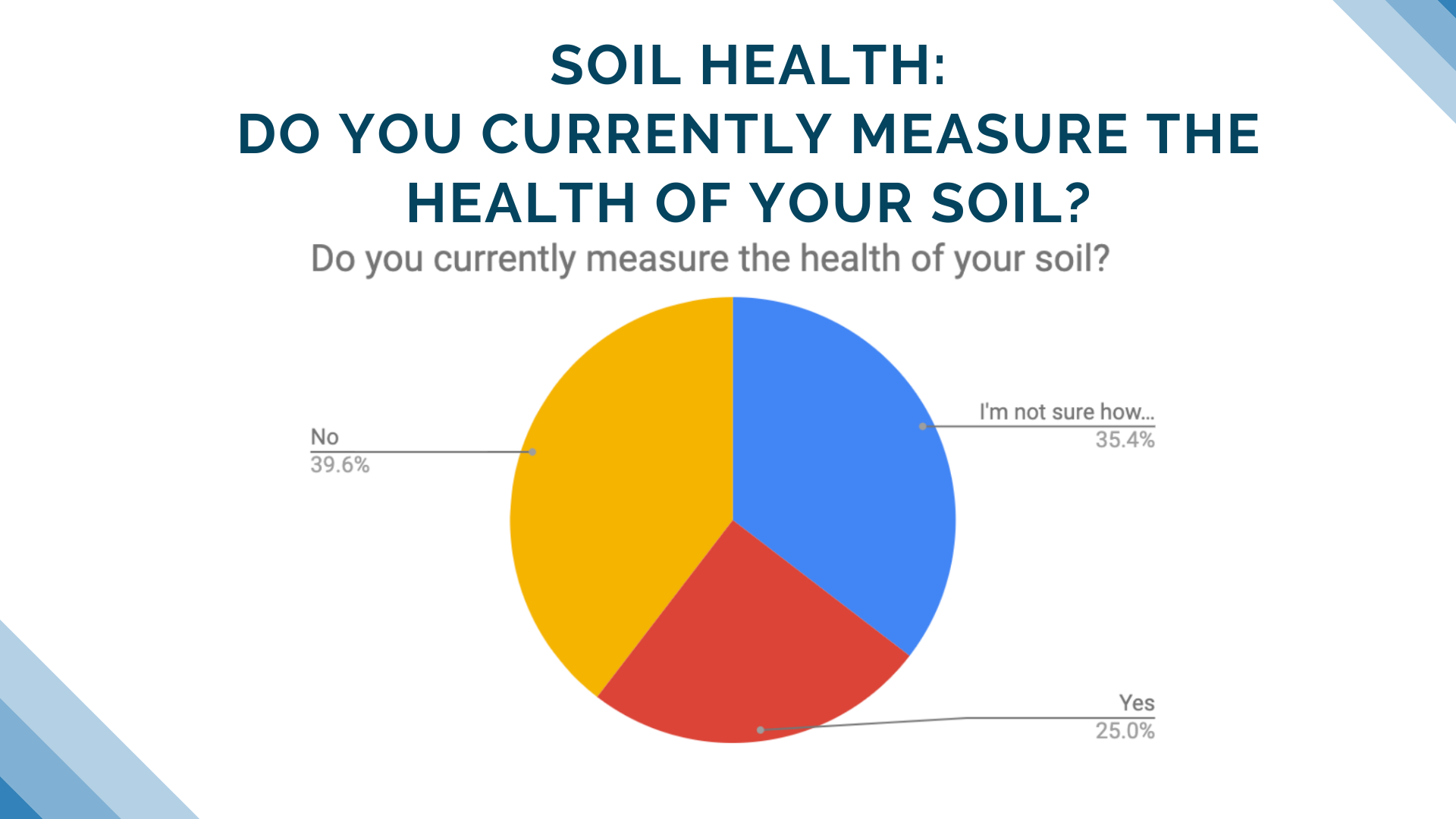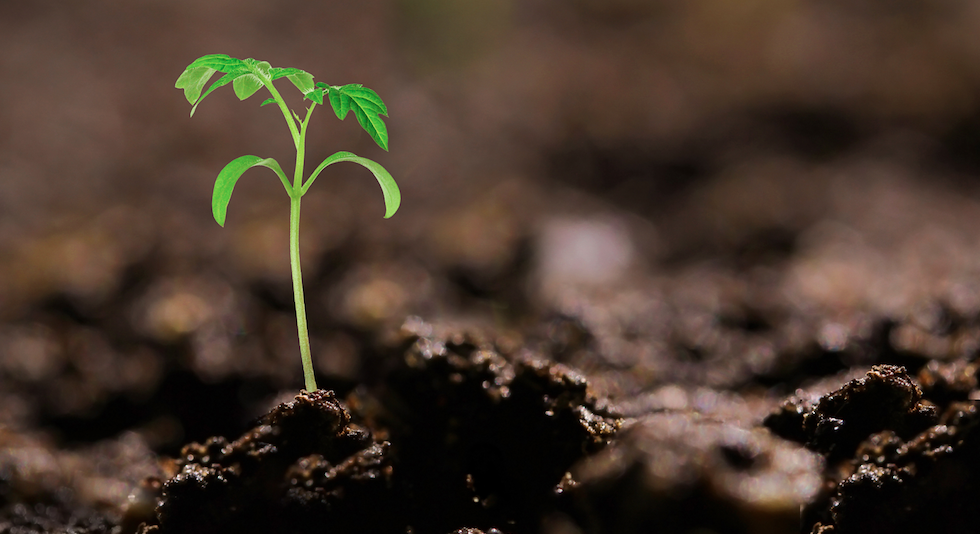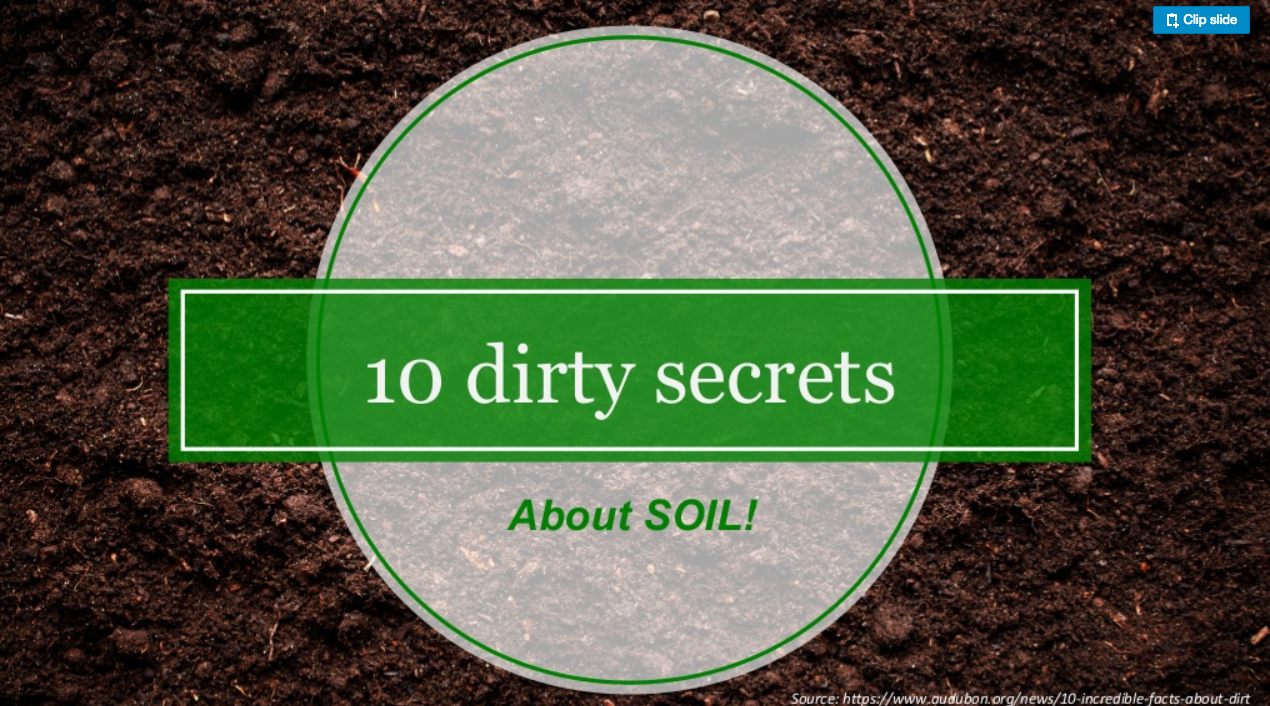
 Kaitlyn Ersek
|
March 3, 2022
|
3:30 PM
Kaitlyn Ersek
|
March 3, 2022
|
3:30 PM
.png?width=1024&name=blog%20header%20(14).png)
It’s no secret that soil health is important. Healthy soils can affect a number of results from crop yield, to disease suppression, nutrient availability, and more.
Earlier this year, we asked growers the question “do you currently measure the health of your soil?” and discovered that approximately 35% of respondents weren’t sure how to measure soil health.

So, how do you effectively measure soil health? Soil scientists, growers, golf course superintendents, and other professionals working the land can evaluate soil health by measuring soil quality indicators.
What are soil quality indicators? According to The National Resource Conservation Service (NRCS), “indicators are measurable properties of soil or plants that provide clues about how well the soil can function.”
Indicators need to be easy to measure either through qualitative or quantitative techniques. Once indicators are gathered, you can evaluate patterns and compare results to neighboring fields or prior years to gauge how soil quality has improved.
In this blog, we provide an overview of the (1) physical properties, (2) biological properties, and (3) chemical properties used as soil quality indicators. Additional information is provided for those that want to dig deeper with thanks to the NRCS, the Soil Health Institute, and other resources. Review our table of contents below and jump to the topic that most interests you.
- Physical Properties
- Aggregate Stability
- Available Water Capacity
- Bulk Density
- Infiltration
- Slaking
- Soil Crusts
- Soil Structure and Macropores
- Biological Properties
- Earthworms
- Particulate Organic Matter
- Potentially Mineralized Nitrogen
- Soil Enzymes
- Soil Respiration
- Total Organic Carbon
- Soil Microbiome
- Chemical Properties
- Why Soil Health Matters at Holganix?
Physical Properties
Physical properties refer to how the soil is formed. Many of the tests around evaluating physical properties can be conducted in the field and few instruments are needed.
Soil scientists and those working the land use seven physical property indicators to measure soil quality.
Soil Aggregate Stability
Soil aggregates are soil particles bound together. Stability refers to the ability of the soil aggregates to maintain their form despite disturbances caused by tilling, water, or wind. Changes in soil aggregate stability are indicators of improved soil health, organic matter content, biological activity, and nutrient cycling.
According to the NRCS, the following practices can improve aggregate stability:
- Cover crops
- Crop rotation
- Tillage management
>> The USDA provides several different methods of measuring soil aggregate stability here.
>> Learn more about soil aggregate stability check out this resource by the NRCS.
Available Water Capacity
Water capacity is the maximum amount of water stored in the soil for the plant. It’s crucial to plant health when water is needed by the plant between irrigation or rainstorms.
According to the NRCS, the following practices can improve available water capacity:
- Crop rotation
- Cover crops
- Tillage management
There are two laboratory tests to measure available water capacity. The first measures how much water the soil holds at field capacity while the second determines the amount of water the soil holds when plants can no longer take in water. The difference between these two tests provides the water available for plant growth.
>> Learn more about available water capacity stability check out this resource by the NRCS.
Bulk Density
Bulk density is an indicator of soil compaction. When soils are too compact, it may restrict root growth which ultimately affects plant growth and crop yield. Additional dangers include increased runoff, erosion, and waterlogged soils.
The NRCS provides the following recommendations to reduce soil bulk density.
- Crop rotation
- Cover crop
- Deep tillage
To measure soil bulk density, a microwave and drying oven is needed.
>> Check out this NRCS resource for additional information on measuring.
Infiltration
The infiltration rate is how quickly water enters the soil. The soil then stores the water to make it available to plants. When soils have poor infiltration, runoff can occur.
The NRCS recommends the following practices to improve infiltration:
- Crop rotation
- Cover crops
- Tillage management
>> Check out this video for a rundown on how to measure infiltration on your field.
>> Learn more about infiltration check out this resource by the NRCS.
Slaking
Slaking explains “how well the soil can maintain its structure to provide water and air for plants and soil microbes when rapidly wetted.” Slaked soil reduces water infiltration and movement and increases runoff and soil erosion.
The NRCS recommends the following practices to reduce slaking:
- Crop rotation
- Cover crops
- Tillage management
>> Check out this video for a 1.5-minute demonstration on how to measure slaking in your fields.
>> Learn more about slaking check out this resource by the NRCS.
Soil Crusts
Soil crust is the layer on the surface of exposed soils. Thick soil crusts can inhibit seedlings from germinating, as well as increase soil erosion and runoff.
The NRCS recommends the following practices to minimize soil crust:
- Crop rotation
- Cover crop
- Tillage management
A penetrometer can measure the penetration resistance of the crust, you could also measure the crust thickness, or simply take a section of crust and apply force until breaking.
>> Learn more about soil crusts check out this resource by the NRCS.
Soil Structure
Soil structure is the combination of sand, silt, and clay particles and affects the ability of water and air movement in the soil and the soil’s ability to store and cycle nutrients.
The NRCS recommends the following practices to improve soil structure:
- Crop rotation
- Cover crop
- Tillage management
- Irrigation
You can measure your soil structure by looking at the soil layers and consulting this NRCS resource. >>Download "Field Book for Describing and Sampling Soils"
Biological Properties
Soil is teeming with billions of soil organisms. Some of these organisms you can see with the naked eye (think earthworms, millipedes, spiders, mites, reptiles, and mammals), others are microscopic (archaea, bacteria, fungi, nematodes, and protozoa).
These organisms play a key role in functions related to crop and plant health including: (1) Nutrient cycling, making nutrients available to the plant, (2) nurturing soil structure, (3) soil pollutant degradation, and (4) breaking down organic matter.
Soil scientists and those working the land use seven biological indicators to measure soil quality.
Earthworms
Earthworms excrete nutrients into the soil, improve soil structure, and root development. According to the NRCS, “there is evidence that earthworms contribute to crop production”.
According to the NRCS, the following practices promote earthworms:
- No-till, low-till, strip-till, ridge-till
- Crop rotation
- Cover crops
- Manures/Compost
- pH management
- Irrigation/drainage
Earthworm populations are measured by counting the number of earthworms/m2.
>> Learn more about earthworms check out this resource by the NRCS.
Particulate Organic Matter
Particulate organic matter includes organic matter between 0.053 mm and 2 mm. It builds soil structure, increases cation exchange capacity, binds environmental pollutants, provides nutrients to plants, and is a source of food to soil organisms. There is also evidence that particulate organic matter plays a role in suppressing soil-borne diseases.
According to the NRCS, the following practices enhance particulate organic matter levels:
- No-till, low-till, strip-till, ridge-till
- Crop rotation
- Cover crops
- Manures/Compost
While there are laboratory methods to measure estimated particulate organic matter, field methods do not yet exist.
>> Learn more about particulate organic matter check out this resource by the NRCS.
Potentially Mineralizable Nitrogen
Potentially mineralized nitrogen is a measurement estimating plant-available nitrogen in the soil. It’s a crucial source of nitrogen for plant growth, especially in organic fields. It also indirectly enhances microbial populations and activity.
According to the NRCS, the following practices increase available nitrogen in soils:
- Applications of manure/compost, nitrogen fertilizer
- No-till, low-till
- Cover crops
- Erosion control which reduces runoff of nitrogen to waterways
To measure potentially mineralizable nitrogen, laboratories use an aerobic or anaerobic method that measures ammonium nitrogen and nitrate nitrogen produced in soil that is incubated for 30 days.
>> Learn more about potentially mineralized nitrogen check out this resource by the NRCS.
Soil Enzymes
Soil enzymes play a role in the decomposition and release of plant-available nutrients. They are derived from living and dead microbes (archaea, bacteria, fungi, nematodes, and protozoa) plant roots and residues, and soil organisms (nematodes, millipedes, insects, mites, spiders, reptiles, and mammals).
According to the NRCS, practices that encourage soil enzymes include:
- Using organic soil amendments
- Crop rotation
- Cover crops
- Modifying pH
Enzymes are measured in the laboratory using biochemical assays.
>> Learn more about soil enzymes check out this resource by the NRCS.
Soil Respiration
Soil respiration is caused by aerobic microbes, plant roots, and other sources.
According to the NRCS, these practices can improve soil organic matter which indirectly affects soil respiration.
- Applications of manure/compost, nitrogen fertilizer
- No-till, low-till
- Rotations with deep-rooted crops
- Application of manure/compost
- Irrigation/drainage
- Traffic
Soil respiration is measured using a Draeger-Tube.
>> Learn more about soil respiration check out this resource by the NRCS.
Total Organic Carbon
According to the NRCS, “total organic carbon is the carbon stored in organic matter.” It functions as a food source for soil microbes.
The following practices increase total organic carbon
- Application of manure/compost
- Using summer/winter cover crops
The following practices reduce total organic carbon
- Harvesting
- Burning
Currently, measuring total organic carbon in the field has been ineffective although laboratory methods are available.
>> Learn more about total organic carbon check out this resource by the NRCS.
Soil Microbiome
While not highlighted in the NRCS handbook on measuring soil health, the soil microbiome is an important biological indicator when determining the health of your soils.
Soil microbes are involved in actually making soil work. Soil microbes (1) breakdown organic matter, (2) cycle all nutrients, (3) build soil structure, (4) build soil organic matter, (5) increase water holding capacity, (6) suppress disease, and more. All of these affect important crop measurements like crop yield and resilience when faced with environmental stress.
Many of the other biological properties discussed above focus on building a home and feeding soil microbes. Only a few of the biological indicators (earthworms, enzymes, and respiration) measure if anything is living in the home. The tests indicated instead measure the suitability of the home for the microbes and roots and indirectly infer these things are living in the soil home.
The second part of the equation is ensuring the necessary microbes are actually living in the soil home.
The following practices can limit soil microbes:
- Flooding
- Freezing
- Tillage
- Crop protection chemicals
- Fertilizers
- Crop types and varieties
The following practices provide soil microbes:
- Composts
- Microbial products that contain strains of soil microbes (Think Holganix Bio 800+!)
Some tests to determine what is living in the soil include the Solvita and Haney tests, phospholipid fatty acid, and metagenomics sequencing (DNA fingerprinting).
For additional information on measuring soil health as it relates to the soil microbiome, consider reviewing these two resources:
Chemical Indicators
Chemical indicators can provide a perspective on the following functions: (1) promoting biodiversity, (2) filtering, buffering, degrading, and detoxifying organic and inorganic materials, (3) controlling water and solute flow, (4) cycling carbon and nutrients, and (5) physical foundation for plants, animals and humans.
When gathering data measured from the field, it’s important to gather a large number of samples as chemical indicator data will vary based on many different factors including water content, soil texture, and others.
Soil scientists, farmers, and other professionals that rely on and work on the land use the four chemical indicators to measure soil quality.
Reactive Carbon
Reactive carbon is a type of organic matter. If reactive carbon decreases, it may signal a decline in soil organic matter. Ultimately, poor soil organic matter can affect soil aggregate stability, reduce water infiltration and water holding capacity, microbial activity, and nutrient availability.
The NRCS recommends the following practices to increase soil organic matter:
- Reduced tillage - no-till
- Adoption of crop rotations cover crops or other crop diversity measures
- Addition of manure, fresh residues, and compost
To measure your reactive carbon levels, see the NRCS Active Carbon Field Test Kit.
>> Learn more about reactive carbon check out this resource by the NRCS.
Soil Electrical Conductivity
Soil Electrical Conductivity measures soil salinity. It is used as an indicator of nutrient availability and salinity levels. According to the NRCS, it “has been used as a surrogate measure of salt concentration, organic matter, cation-exchange capacity, soil texture, soil thickness, nutrients, and water holding capacity.”
To decrease your soil electrical conductivity, irrigation practices that wash soluble salts out of soil can help. On the other hand, to increase your soil electrical conductivity, consider adding organic matter (think manures or compost).
To measure the soil electrical conductivity, use an EC Pocket meter. Mapping for precision agriculture also uses special sensors to measure levels.
>> Learn more about soil electrical conductivity check out this resource by the NRCS.
Soil Nitrate
Nitrate is not plant-available. It is added to the soil by plant decomposition, compost/manure, fertilizers, and other sources and is converted to plant-available forms (nitrite and ammonium) by aerobic soil microbes in a process called nitrification. Conversely, anaerobic soil microbes lead to nitrogen loss in a process called denitrification. Anaerobic soil microbes can be found when soils become anaerobic, such as in waterlogged fields.
According to the NRCS, the following practices add nitrate:
- Crop rotations with legumes
- Addition of organic residues, manure, and compost
- Conservation tillage and field strips or no-till with a winter cover crop
- Split applications of fertilizer that match crop growth stages
According to the NRCS, the following practices reduce nitrate loss:
- Autumn applications of ammonium-based fertilizer on frozen soils
- Application of materials that slowly release nitrogen
- Planting cover crop species that use residual nitrates
- Planning the timing and rates of irrigation according to site water content
- Keeping the soil well-drained
- Additions of green manure with a high Carbon to Nitrogen ratio
Nitrate levels can be measured using a test strip and take just 15 minutes.
>> Learn more about soil nitrate check out this resource by the NRCS.
Soil pH
Soil pH can affect plant growth, crop yields, biological activity, and more. It is a measurement of the soil acidity or alkalinity and ranges from a scale of 0 to 14. A pH is neutral at 7, whereas values above 7 are considered alkaline and those below are considered acidic.
The NRCS, recommends the following practices to improve soil pH
- Liming
- Crop rotations
- Applying ammonium-based fertilizers, urea, sulfur
- Using acidifying residues (think pine needles and sawdust)
- Increasing organic matter
You can measure the pH of your soil using a pH pocket meter.
>> Learn more about soil pH check out this resource by the NRCS.
Why Soil Health Matters at Holganix?
At Holganix we revolutionize the way the world grows by harnessing the power of soil microbes. In fact, our flagship product Holganix Bio 800+ contains over 800 species of beneficial soil microbes that work to build soil and plant health naturally. Our products are used by farmers to increase crop yields and by landscapers and golf courses to reduce their need for fertilizer and pesticides. It’s official, SOIL MATTERS!
Check out these resources to learn more about what Holganix Bio 800+ can do for you:
- >> Review our agriculture data
- >> Review our turf and ornamental data
- >> Read and watch our case studies featuring customer experience stories
What’s The Dirt On Soil Science?
Digging into Soil Science 101: Beginners Guide to Understanding the Soil Food Web eBook
We know soils are important and we know why we should be grateful for healthy soils. But, how do soils work? And, what does healthy soil look like? Dig deeper into soil science by downloading our FREE eBook by Holganix Director of Soil and Plant Science, Dr. Robert Neidermyer.
Download our eBook to explore:
- How the soil food web supports healthy crops
- The power behind soil microbes and what they do to build resilient crops
- Soil types and how to improve the health of your soil
Comments
- blog (423)
- lawn care (378)
- agriculture (221)
- golf course (205)
- sports turf (202)
- holganix reviews (168)
- story (126)
- Holganix Bio 800 (32)
- farmers (28)
- soil health (24)
- soil (17)
- trees (16)
- webinar (16)
- Holganix Bio 800 Breakdown (14)
- holganix case studies (12)
- Holganix Bio 800 Agriculture (11)
- Soil heath (10)
- soil microbes (10)
- Holganix Bio 800+ Revive (9)
- carbon (9)
- crop residue (8)
- holganix results (8)
- fertilizer (7)
- Gratitude (6)
- turf (6)
Related Posts




-1.png)




-1.jpg)
-1.jpg)
-1.jpg)
.jpg)

.jpg)
.webp)
-1%20(1).webp)
-831535-2.webp)


